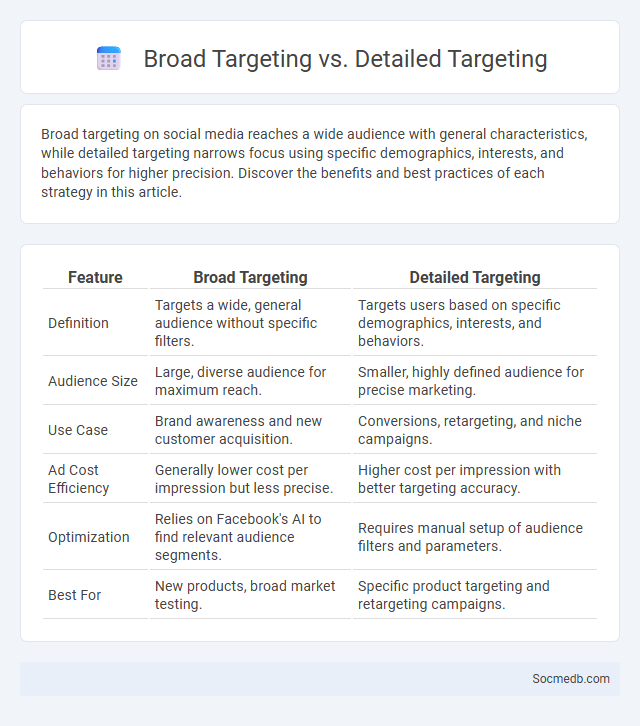
Photo illustration: Broad Targeting vs Detailed Targeting
Broad targeting on social media reaches a wide audience with general characteristics, while detailed targeting narrows focus using specific demographics, interests, and behaviors for higher precision. Discover the benefits and best practices of each strategy in this article.
Table of Comparison
| Feature | Broad Targeting | Detailed Targeting |
|---|---|---|
| Definition | Targets a wide, general audience without specific filters. | Targets users based on specific demographics, interests, and behaviors. |
| Audience Size | Large, diverse audience for maximum reach. | Smaller, highly defined audience for precise marketing. |
| Use Case | Brand awareness and new customer acquisition. | Conversions, retargeting, and niche campaigns. |
| Ad Cost Efficiency | Generally lower cost per impression but less precise. | Higher cost per impression with better targeting accuracy. |
| Optimization | Relies on Facebook's AI to find relevant audience segments. | Requires manual setup of audience filters and parameters. |
| Best For | New products, broad market testing. | Specific product targeting and retargeting campaigns. |
Introduction to Facebook Ad Targeting Strategies
Facebook ad targeting strategies leverage user data such as demographics, interests, and behaviors to create highly specific audience segments. Utilizing tools like Custom Audiences, Lookalike Audiences, and detailed targeting options increases ad relevance and boosts conversion rates. Effective targeting reduces ad spend wastage while enhancing campaign performance on the Facebook platform.
What is Broad Targeting?
Broad targeting in social media advertising refers to reaching a wide, general audience without narrowing down specific demographics, interests, or behaviors. This approach allows platforms like Facebook and Instagram to use their algorithms to optimize ad delivery to users most likely to engage or convert. Broad targeting can increase brand awareness and maximize exposure, especially useful for new product launches or campaigns aiming for mass reach.
Advantages of Broad Targeting
Broad targeting on social media maximizes your reach by connecting with a diverse audience, increasing brand awareness and engagement opportunities. It leverages algorithms to identify potential customers beyond predefined demographics, boosting the efficiency of ad spend. This approach helps you discover new market segments and drives scalable growth for your business.
What is Detailed Targeting?
Detailed targeting in social media advertising allows marketers to define audiences based on specific demographics, interests, behaviors, and location data gathered from user profiles and activity. This feature enables advertisers to reach highly relevant segments by combining multiple criteria, improving ad relevance and engagement rates. Platforms like Facebook and Instagram utilize detailed targeting to enhance campaign precision and optimize return on investment.
Benefits of Detailed Targeting
Detailed targeting in social media advertising allows brands to reach specific audiences based on demographics, interests, and behaviors, enhancing campaign precision and ROI. This method improves ad relevance, increases engagement rates, and reduces wasted ad spend by connecting with users most likely to convert. Leveraging data-driven targeting strategies helps optimize budget allocation and drives higher conversion rates across platforms like Facebook, Instagram, and LinkedIn.
Understanding the Ad Auction System
The ad auction system on social media platforms determines which ads are displayed to users by evaluating bids, ad quality, and relevance scores. Advertisers compete in real-time auctions where algorithms prioritize ads based on user engagement potential and budget constraints. Mastering this system enables brands to optimize ad spend and achieve higher return on investment through targeted audience reach and improved conversion rates.
How Broad and Detailed Targeting Affect Ad Auction
Broad targeting in social media advertising increases audience reach but may reduce ad relevance, leading to higher competition and costs in the ad auction. Detailed targeting narrows the audience using specific demographics, interests, and behaviors, improving ad relevance and engagement, which can lower bid prices and increase ad placement priority. Effective balancing of broad and detailed targeting optimizes bid performance and maximizes return on investment in the social media ad auction ecosystem.
Comparing Performance: Broad vs Detailed Targeting
Broad targeting on social media reaches a larger, more diverse audience, increasing brand awareness but may dilute conversion rates due to less precise interest alignment. Detailed targeting focuses on specific demographics, behaviors, and interests, enhancing your ad relevance and potential ROI by reaching users more likely to engage or convert. Understanding your campaign goals helps you decide whether broad reach or laser-focused targeting will maximize performance and budget efficiency.
When to Use Broad or Detailed Targeting
Broad targeting on social media maximizes audience reach by leveraging platform algorithms to identify potential customers based on generalized demographics and behaviors. Detailed targeting narrows the audience using specific attributes such as interests, location, age, and purchasing habits to increase ad relevance and conversion rates. Choosing between broad and detailed targeting depends on campaign goals, budget size, and data availability, with broad targeting effective for brand awareness and detailed targeting preferred for precise lead generation or sales.
Best Practices for Optimizing Ad Auction Results
Maximize your ad auction success by targeting the most relevant audiences using detailed demographic and interest-based data available on social media platforms. Utilize A/B testing to refine ad creatives and bidding strategies, ensuring higher engagement and cost-effectiveness. Monitor real-time metrics closely to adjust bids dynamically, increasing the likelihood your ad wins optimal placement and delivers better ROI.
 socmedb.com
socmedb.com